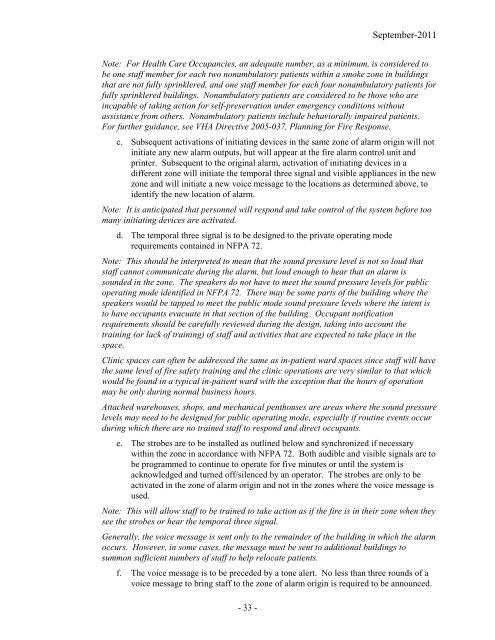Fire Protection Design Manual - Office of Construction and Facilities ...
Fire Protection Design Manual - Office of Construction and Facilities ...
Fire Protection Design Manual - Office of Construction and Facilities ...
You also want an ePaper? Increase the reach of your titles
YUMPU automatically turns print PDFs into web optimized ePapers that Google loves.
September-2011<br />
Note: For Health Care Occupancies, an adequate number, as a minimum, is considered to<br />
be one staff member for each two nonambulatory patients within a smoke zone in buildings<br />
that are not fully sprinklered, <strong>and</strong> one staff member for each four nonambulatory patients for<br />
fully sprinklered buildings. Nonambulatory patients are considered to be those who are<br />
incapable <strong>of</strong> taking action for self-preservation under emergency conditions without<br />
assistance from others. Nonambulatory patients include behaviorally impaired patients.<br />
For further guidance, see VHA Directive 2005-037, Planning for <strong>Fire</strong> Response.<br />
c. Subsequent activations <strong>of</strong> initiating devices in the same zone <strong>of</strong> alarm origin will not<br />
initiate any new alarm outputs, but will appear at the fire alarm control unit <strong>and</strong><br />
printer. Subsequent to the original alarm, activation <strong>of</strong> initiating devices in a<br />
different zone will initiate the temporal three signal <strong>and</strong> visible appliances in the new<br />
zone <strong>and</strong> will initiate a new voice message to the locations as determined above, to<br />
identify the new location <strong>of</strong> alarm.<br />
Note: It is anticipated that personnel will respond <strong>and</strong> take control <strong>of</strong> the system before too<br />
many initiating devices are activated.<br />
d. The temporal three signal is to be designed to the private operating mode<br />
requirements contained in NFPA 72.<br />
Note: This should be interpreted to mean that the sound pressure level is not so loud that<br />
staff cannot communicate during the alarm, but loud enough to hear that an alarm is<br />
sounded in the zone. The speakers do not have to meet the sound pressure levels for public<br />
operating mode identified in NFPA 72. There may be some parts <strong>of</strong> the building where the<br />
speakers would be tapped to meet the public mode sound pressure levels where the intent is<br />
to have occupants evacuate in that section <strong>of</strong> the building. Occupant notification<br />
requirements should be carefully reviewed during the design, taking into account the<br />
training (or lack <strong>of</strong> training) <strong>of</strong> staff <strong>and</strong> activities that are expected to take place in the<br />
space.<br />
Clinic spaces can <strong>of</strong>ten be addressed the same as in-patient ward spaces since staff will have<br />
the same level <strong>of</strong> fire safety training <strong>and</strong> the clinic operations are very similar to that which<br />
would be found in a typical in-patient ward with the exception that the hours <strong>of</strong> operation<br />
may be only during normal business hours.<br />
Attached warehouses, shops, <strong>and</strong> mechanical penthouses are areas where the sound pressure<br />
levels may need to be designed for public operating mode, especially if routine events occur<br />
during which there are no trained staff to respond <strong>and</strong> direct occupants.<br />
e. The strobes are to be installed as outlined below <strong>and</strong> synchronized if necessary<br />
within the zone in accordance with NFPA 72. Both audible <strong>and</strong> visible signals are to<br />
be programmed to continue to operate for five minutes or until the system is<br />
acknowledged <strong>and</strong> turned <strong>of</strong>f/silenced by an operator. The strobes are only to be<br />
activated in the zone <strong>of</strong> alarm origin <strong>and</strong> not in the zones where the voice message is<br />
used.<br />
Note: This will allow staff to be trained to take action as if the fire is in their zone when they<br />
see the strobes or hear the temporal three signal.<br />
Generally, the voice message is sent only to the remainder <strong>of</strong> the building in which the alarm<br />
occurs. However, in some cases, the message must be sent to additional buildings to<br />
summon sufficient numbers <strong>of</strong> staff to help relocate patients.<br />
f. The voice message is to be preceded by a tone alert. No less than three rounds <strong>of</strong> a<br />
voice message to bring staff to the zone <strong>of</strong> alarm origin is required to be announced.<br />
- 33

















